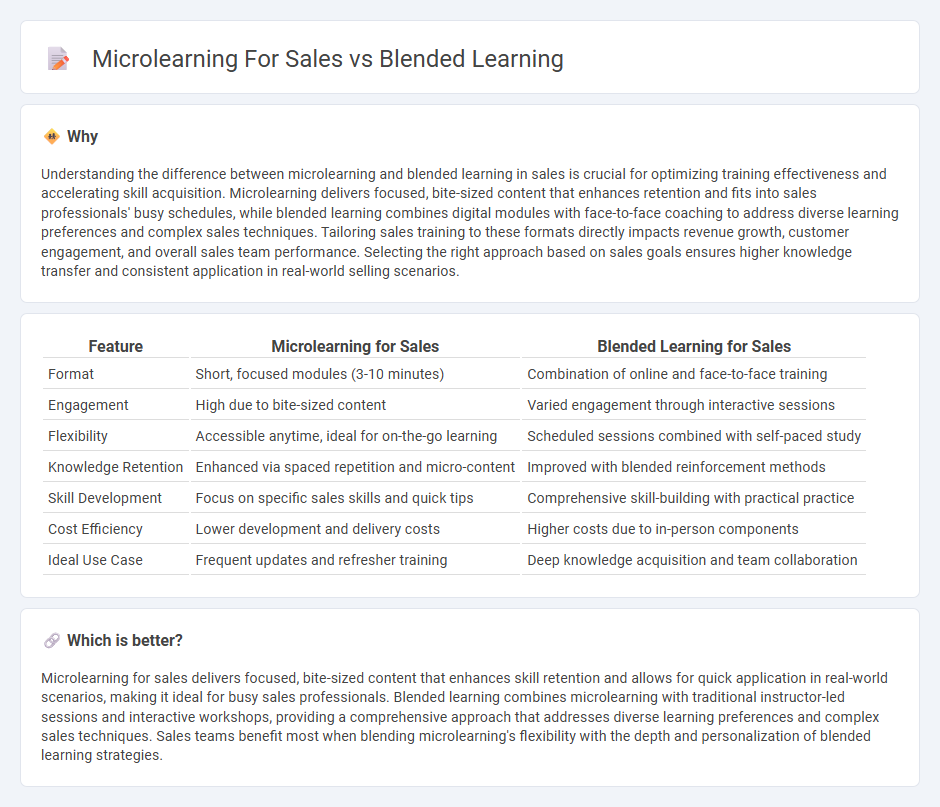
Microlearning in sales offers concise, focused training modules that enhance skill retention and adaptability, enabling sales teams to quickly apply new techniques in dynamic environments. Blended learning combines microlearning with longer, interactive sessions to provide comprehensive knowledge and practical experience, catering to diverse learning preferences. Explore how integrating both approaches can optimize your sales training strategy and boost performance.
Why it is important
Understanding the difference between microlearning and blended learning in sales is crucial for optimizing training effectiveness and accelerating skill acquisition. Microlearning delivers focused, bite-sized content that enhances retention and fits into sales professionals' busy schedules, while blended learning combines digital modules with face-to-face coaching to address diverse learning preferences and complex sales techniques. Tailoring sales training to these formats directly impacts revenue growth, customer engagement, and overall sales team performance. Selecting the right approach based on sales goals ensures higher knowledge transfer and consistent application in real-world selling scenarios.
Comparison Table
| Feature | Microlearning for Sales | Blended Learning for Sales |
|---|---|---|
| Format | Short, focused modules (3-10 minutes) | Combination of online and face-to-face training |
| Engagement | High due to bite-sized content | Varied engagement through interactive sessions |
| Flexibility | Accessible anytime, ideal for on-the-go learning | Scheduled sessions combined with self-paced study |
| Knowledge Retention | Enhanced via spaced repetition and micro-content | Improved with blended reinforcement methods |
| Skill Development | Focus on specific sales skills and quick tips | Comprehensive skill-building with practical practice |
| Cost Efficiency | Lower development and delivery costs | Higher costs due to in-person components |
| Ideal Use Case | Frequent updates and refresher training | Deep knowledge acquisition and team collaboration |
Which is better?
Microlearning for sales delivers focused, bite-sized content that enhances skill retention and allows for quick application in real-world scenarios, making it ideal for busy sales professionals. Blended learning combines microlearning with traditional instructor-led sessions and interactive workshops, providing a comprehensive approach that addresses diverse learning preferences and complex sales techniques. Sales teams benefit most when blending microlearning's flexibility with the depth and personalization of blended learning strategies.
Connection
Microlearning for sales enhances skill retention through brief, focused training modules that reinforce key concepts, while blended learning integrates these bite-sized lessons with traditional face-to-face coaching and digital resources. This combination accelerates sales team performance by catering to diverse learning preferences and ensuring continuous knowledge reinforcement. Data shows sales organizations using blended microlearning report up to 30% improvement in quota attainment and faster onboarding times.
Key Terms
Training Delivery Methods
Blended learning combines traditional instructor-led sessions with online modules, offering sales teams flexibility and interactive engagement, while microlearning breaks content into brief, focused segments that enhance retention and accommodate busy schedules. Effective training delivery methods for sales leverage the strengths of both approaches to boost skill acquisition and on-the-job application. Explore comprehensive strategies to optimize your sales training delivery methods.
Content Retention
Blended learning combines traditional instructor-led training with digital resources, enhancing content retention through varied engagement methods and real-time feedback. Microlearning delivers concise, focused modules that improve retention by targeting specific sales skills and enabling repeated, on-demand review. Explore how these approaches can optimize your sales team's learning outcomes and boost long-term performance.
Learner Engagement
Blended learning combines traditional face-to-face instruction with digital content, enhancing sales training by catering to diverse learning styles and increasing learner engagement through interactive sessions and real-time feedback. Microlearning delivers concise, focused modules tailored for busy sales professionals, boosting retention and motivation by providing just-in-time knowledge in easily digestible segments. Explore how blending these approaches can maximize engagement and sales performance.
Source and External Links
Blended Learning - Examples & More - Blended learning is an instructional approach that combines digital or online learning materials with traditional face-to-face classroom methods for a more flexible, integrated educational experience.
5 Blended Learning Strategies to Try in Middle and High School - Blended learning is a formal education program where students learn partly online with control over time, place, path, and pace, and partly in a supervised physical location, ensuring an integrated and personalized learning journey.
Blended Learning | Columbia CTL - Blended learning is a learner-centered approach that intentionally integrates complementary face-to-face (synchronous) and online (asynchronous) learning experiences to enhance student outcomes and meet learning objectives.
 dowidth.com
dowidth.com